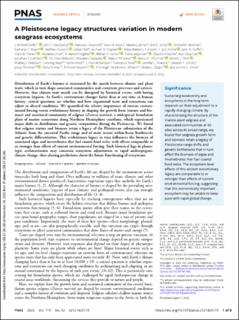A Pleistocene legacy structures variation in modern seagrass ecosystems
Duffy, J. Emmett; Stachowicz, John J.; Reynolds, Pamela L.; Hovel, Kevin A.; Jahnke, Marlene; Sotka, Erik E.; Boström, Christoffer; Boyer, Katharyn E.; Cusson, Mathieu; Eklöf, Johan; Engelen, Aschwin H.; Eriksson, Britas Klemens; Fodrie, F. Joel; Griffin, John N; Hereu, Clara M.; Hori, Masakazu; Hughes, A. Randall; Ivanov, Mikhail V.; Jorgensen, Pablo; Kruschel, Claudia; Lee, Kun-Seop; Lefcheck, Jonathan S.; Moksnes, Per-Olav; Nakaoka, Masahiro; O’Connor, Mary I.; O’Connor, Nessa E.; Orth, Robert J.; Peterson, Bradley J.; Reiss, Henning; Reiss, Katrin; Richardson, J. Paul; Rossi, Francesca; Ruesink, Jennifer L.; Schultz, Stewart T.; Thormar, Jonas; Tomas, Fiona; Unsworth, Richard; Voigt, Erin; Whalen, Matthew A.; Ziegler, Shelby L.; Olsen, Jeanine L.
Peer reviewed, Journal article
Published version
Permanent lenke
https://hdl.handle.net/11250/3035268Utgivelsesdato
2022Metadata
Vis full innførselSamlinger
- Articles [3012]
- Publikasjoner fra CRIStin [3070]
Originalversjon
Proceedings of the National Academy of Sciences of the United States of America. 2022, 119 (32), . 10.1073/pnas.2121425119Sammendrag
Distribution of Earth’s biomes is structured by the match between climate and plant traits, which in turn shape associated communities and ecosystem processes and services. However, that climate–trait match can be disrupted by historical events, with lasting ecosystem impacts. As Earth’s environment changes faster than at any time in human history, critical questions are whether and how organismal traits and ecosystems can adjust to altered conditions. We quantified the relative importance of current environmental forcing versus evolutionary history in shaping the growth form (stature and biomass) and associated community of eelgrass (Zostera marina), a widespread foundation plant of marine ecosystems along Northern Hemisphere coastlines, which experienced major shifts in distribution and genetic composition during the Pleistocene. We found that eelgrass stature and biomass retain a legacy of the Pleistocene colonization of the Atlantic from the ancestral Pacific range and of more recent within-basin bottlenecks and genetic differentiation. This evolutionary legacy in turn influences the biomass of associated algae and invertebrates that fuel coastal food webs, with effects comparable to or stronger than effects of current environmental forcing. Such historical lags in phenotypic acclimatization may constrain ecosystem adjustments to rapid anthropogenic climate change, thus altering predictions about the future functioning of ecosystems.
